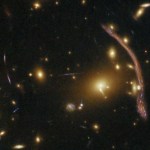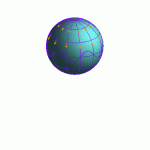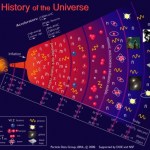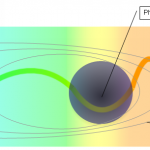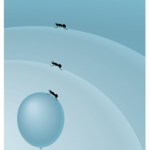gravity
Earlier this week, I wrote about an article that appeared in Nature, New Scientist and other places. The article -- and especially the popular writeups -- talked about a problem with dark matter and how MOND (MOdified Newtonian Dynamics) solves those problems.
And I'm livid about it. Another physicist/scienceblogger thinks my anger is misplaced, and left me the following in my comments section:
Ethan - this is not a creationism debate.
Hong Sheng is a top dynamicist and he knows perfectly well what the issues are.
The whole point of science at this level is to test models and propose…
There were a couple of things that bothered me about the MythBusters' myth where they fired bullets in the air. The myth was that a bullet fired in the air could kill you. The first problem is that it is not a myth. There are several reported cases of people being killed from bullets that were fired in the air. The Mythbusters tested this by finding out how fast a bullet would be going if fired straight up. A couple of problems:
First, they measured the terminal velocity of a tumbling bullet, not a spinning one. I really don't know how long a bullet will stay spinning, but I guess this…
Deep into the darkness peering,
long I stood there, wondering, fearing,
Doubting, dreaming dreams no mortal ever dared to dream before.
-Edgar Allen Poe, The Raven
Gazing out into the dark abyss of the night sky, stars, galaxies, and clusters shine like tiny islands of light against the blackness of deep space. Trillions upon trillions of protons and neutrons fuse together in stars across the Universe, producing all of this light, and decorating the sky above.
But, as we learned in part one of this series, the starlight that we see only accounts for 2% of all the matter that gravity tells us…
Long you live and high you fly
Smiles you'll give and tears you'll cry
All you touch and all you see
Is all your life will ever be. -Pink Floyd
In part I of this series, we talked about a number of different ways -- all using gravity -- to measure the amount of matter in galaxies, clusters of galaxies, and the entire Universe. We got the same measurement no matter which method we used, finding out that 25-30% of the total energy of the Universe is in some type of matter. But, only about 0.5% of the total energy is in stars, which means that nearly all of this matter doesn't give off light! So…
Gravitational lensing happens when a cluster of galaxies happens to be directly between us and an even more distant galaxy. The light from these distant galaxies gets warped into arcs and, oftentimes, multiple images. This shot from the new Hubble camera shows exactly what I'm talking about:
Well, there are hundreds, if not thousands of these known galaxies stretched into multiple images. It's only a matter of time before we see one of these in a lensed galaxy:
Supernova! But what's amazing about this is that if we have multiple images, we'll only see the supernova go off in one of them!…
Before you ask yourself, "what kind of incendiary title is that," let me put this in perspective. In 2001, I started graduate school at the University of Florida, and in 2002, I took one of the most difficult year-long courses a physics student can take: Quantum Field Theory. This was both the best and worst course I've ever taken. I worked harder for it than I ever have for any other course, I learned more for doing it than I had at any other time, it was the most difficult time I've ever had in a course, and it was superbly taught by one Richard Woodard. Quantum field theory is possibly the…
I found this in the most recent issue of The Physics Teacher (September 2009). Surprisingly, there were several good articles in this issue. One article discusses a doable version of the Millikan Oil drop experiment. Maybe you are not a (or were not) a physics major, so you might not be familiar with how cool, but tedious and squinty the oil drop experiment can be.
In the Millikan Oil drop experiment, small electrically charged drops of oil are placed in a constant electric field. It turns out that a small enough number of electrons are on each drop so that the quantization of charge can…
Forgive me if I don't know the official parkour term for this move. This is where you have two walls that are close to each other and you vertically climb them. Here is a shot of Mark Witmer (from Ninja Warrior) doing the wall climb.
Doesn't look too hard, does it? Well, I think it depends on how far apart the two walls are. This is actually one parkour move that my kids like to do (Hey kids! Don't do that! Let me get my camera though because this will be perfect for my blog)
I am going to start with this second kind of wall climb. Simply because it is easier due to symmetry. So,…
Okay. Yesterday, I explained to you that the only thing that determines how the Universe expands is the amount of energy density in it. But many of you wanted more details. So, by popular demand -- including one insistence that there is no equation that tells us how the Universe expands -- here is the simplest explanation with math that I can come up with for the expanding Universe. If you hate or don't care about math, do not read this. This article is not for you. But if you're curious, read on.
Image credit: Wayne Hu.
First, let me tell you the underlying assumption behind all of it. You…
So, the Universe started with a bang. Everything was hot, dense, and expanding.
It's 13.7 billion years later now, and our Universe is cold and sparse. The temperature of the leftover glow from the big bang -- which used to be over 10^30 degrees -- is now down to 2.7 Kelvin, just barely above absolute zero. The Universe used to be denser than the center of the Sun. Now, on average, the density of the Universe is only about one proton per cubic meter, with mass clumped into stars and galaxies separated by trillions of miles.
But, for all of it, the Universe is still expanding. What's amazing…
Thanks to Nick for showing me this video (Check out his blog - Fine Structure):
See more funny videos and TBT Videos at Today's Big Thing.
Wow. That was my first reaction. My second reaction was: no way. Is this real life? I just don't know. How hard would it be to find out exactly where to place that pool and where did they get the water from? Obviously, this one requires some analysis. First, on the VAS for this video: 4/8. Not too good. Oh here are the questions I would like to answer:
What is the guy's acceleration after he leaves the ramp?
What was his initial velocity…
Last week, we began talking about understanding the size of the Universe, and we continued this week with some information on distances and motion in the Universe. This brings us to my favorite application, which leads to the Hubble expansion:
Redshift. You see, whenever an atom or molecule emits light, it gives off that light at a very few particular wavelengths. For instance, if you have hydrogen, you'll always get light at wavelengths of 656 nanometers (red), 486 nm (cyan), 434 nm (indigo), 410 nm (violet), and 397 nm (on the border of violet/ultraviolet):
Now there are three things --…
Check this out (saw it on the interwebs):
It's this video inside a bus of a girl hitting the roof. My first thought was: well, she just jumped. But something was odd. She was in the air too long. Well, of course this calls for a video analysis (using Tracker Video Analysis). Actually, it is a good candidate for analysis. Primarily because the motion happens right next to the back of the bus and the bus can be considered the reference frame. The only problem is the scale. I totally guessed that the back window was 3 feet, but not sure this even matters. Here is the motion of the girl…
At the end of last week, I wrote a post explaining how the Universe is so big (93 billion light years across) when it's only 13.7 billion years old. The key visualization is to think of space as being the surface of an expanding balloon, while all the things in the Universe (stars, galaxies, etc.) are like ants on that surface.
Now, I explained to you that two ants will appear to move apart from one another due to the expansion of the Universe, even though neither ant is moving relative to the surface of the balloon. If I use light to measure whether this other ant is moving away from me, I…
Every introductory astronomy text and most intro physics texts talk about tides. The usual explanation is something along the lines of:
The moon exerts a gravitational force on the Earth and all the stuff on the Earth.
This force decreases with distance (1/r2).
Thus the moon pulls greater on one side of the Earth than the other
This doesn't matter except for oceans which can move.
BOOM. Two tides a day due to a bulge on the side close to the moon and the opposite side.
Oh, the Earth is slowing down.
Really, that is what almost all intro texts say. Go check for yourselves.
Yes, the tides…
Sciencegeekgirl is blogging from the AAPT. She talks about showing something interesting to get students thinking, and here is her example:
This reminds me of Dan Meyer's What Can You Do With This stuff. Anyway, I can't help it. I must analyze this video. Plus, Fran essentially threw down the gauntlet and called me out on this move. Another reason to analyze this movie is that it is obviously fake. Elephants are one of the few animals that can't jump. Not even a little bit. They don't like to have more than 1 foot off the ground. Ok, on to the analysis. As usual, I downloaded the…
Yesterday, I uploaded a post from my old site about slowing down time to make videos look like they were on the moon. If you haven't read that, the short story is that it doesn't look right when speed Apollo videos up so that the acceleration is -9.8 m/s2.
What started that whole thing was an even earlier post. Here is an example of using video analysis (Tracker Video Analysis) to measure the acceleration of a jumping astronaut on the moon. In this case, it is the famous "jump salute" from Apollo 16 astronaut John Young.
First, thanks John (or whoever videoed it). This is a good video for…
Note: This is a repost from my old site. Time to move it over.
First, what is different about motion on the moon and on Earth? Since the moon has a smaller mass in spite of its smaller size*, the moon has a smaller gravitational field. The gravitational field on the surface of the moon is 1/6th the field on the surface of the Earth. This means that the acceleration of a free falling on the object would be 1/6th the acceleration on Earth. So the question is: how would you change the time scale of a movie so that it looks like its acceleration is 1/6th of 9.8 m/s2?
*If you make the size of…
July 4th can be fun. One activity my family enjoys is playing in the lake at my parents house. Along with this comes the jumping off the dock. Great fun, and great physics. Here is a short clip.
Work Energy Example from Rhett Allain on Vimeo.
Notice that I violated my own rules for making videos. In particular, the camera was not perpendicular to the motion. Also, I can handle panning cameras, but not when there is nothing but sky in the background. This video is therefore not appropriate for a video analysis. That is ok. I don't need it to talk about physics. So, here is the…
Or, to put it as one of my readers/questioners did,
Why doesn't the Space Needle, a top-heavy skyscraper, ever tip over and fall?
This is reasonable, and there's precedent for this. After all, the Leaning Tower of Pisa was falling over, and needed significant foundation-work just to keep it upright.
Now, when you take something like the Space Needle, it looks like most of the weight is in the top:
And it looks even more significant if you stand at the bottom and look up:
Yet, in actuality, the Space Needle is one of the most stable structures ever, and will be one of the last buildings…



